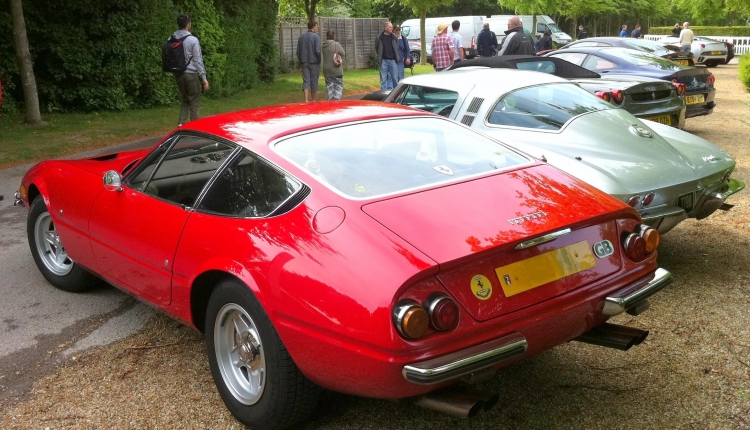The Daytona faces off against its cheaper brother.
The Ferrari 365GTB/4 Daytona is one of the most iconic classic Ferraris. The combination of a powerful V12 engine, great looks and huge performance even by today's standards has meant the popularity of this model has endured. The downside to this is that the Daytona has always been an expensive car and remains so today. As I recently discussed, even a Daytona in need of some TLC is likely to set you back at least £150,000.
Within the classic Ferrari world there is a perception that its lesser-known brother, the 365GTC/4, offers much of the same attributes for little more than half the price. On paper that's true; both cars were sold side by side and both offer 4.4 liter V12 engines that produce over 300 horsepower. However, as with many things, on paper the stats might be similar but in reality both are significantly different. Drive Cult has taken the opportunity to compare the two and find out if the GTC/4 really is a hidden gem that the classic Ferrari market has unfairly ignored.
Full disclosure: as you have probably guessed the Daytona used for this test is mine and you can read about it elsewhere on the site. The comparison is with two 365GTC/4s, both of which belong to my Dad. All three cars have slight differences and modifications from when they left the factory, and I'll point out these changes as we go. The Daytona and blue GTC/4 are UK market right-hand drive models, whilst the red GTC/4 is a left-hand drive European model.
History
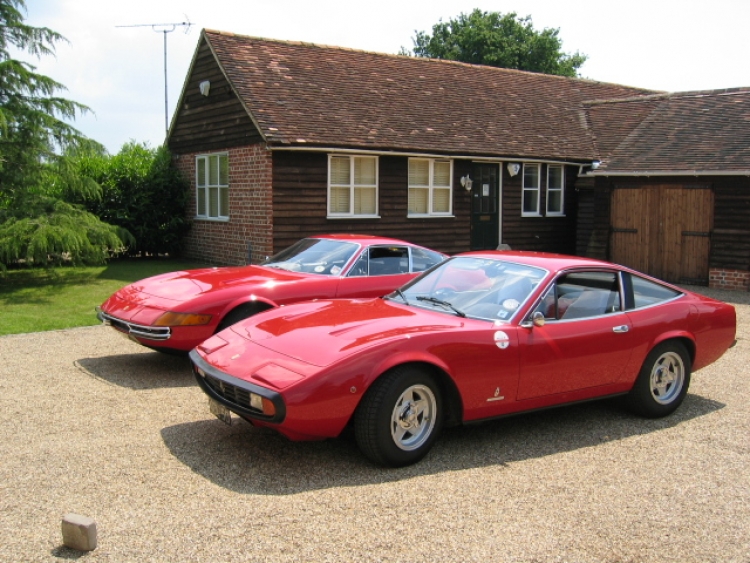
I suspect most readers are fairly familiar with the Daytona. Launched at the Paris Salon in 1968 as Ferrari's top line Berlinetta, it was developed from and replaced the 275GTB/4. A strict two-seater, the Daytona was, to many critics' surprise, front-engined at a time when the new fad was for mid-engined cars. Despite some people considering it to be a dinosaur, the Daytona soon won praise for its high speed stability and excellent handling. The only significant change during its production was to the front end styling, which was revised in 1971 to replace the original plexiglass covered headlamps with pop-up items to comply with US regulations. An open Spyder version, the 365GTS/4, was added to the rang at around the same time. Production ran through to 1973, by which time 1284 Berlinettas and 122 Spyders were made.
The 365GTC/4 joined the range at the Geneva show of 1971 and as such was the first V12-engined car to have been developed after Fiat took 50% control of the company. The C4 (as I will refer to them for the rest of the article) followed on from two models, the 365GTC (a car with very different styling) and the 365GT 2+2. Compared with the Daytona, it offered 2+2 seating, although the rear seats are very marginal for all but the smallest of children!
The C4 was destined to have a very short sales life, since its replacement - the mechanically identical 365GT4 2+2 - was unveiled a mere 18 months later at the Paris Salon of 1972. Despite its short life, the C4 was a sales success. 500 examples found homes which meant it actually outsold the Daytona in that period, despite being a more expensive car when new. The vast majority of C4s went to the United States, with around thirty being made in right-hand drive. In modern terms, the Daytona and C4's equivalents would be the 599 and the 612 Scaglietti respectively.
Styling
This is very much a matter of personal preference and I'll leave you to form your own opinions as to which car is better-looking. As I've already mentioned, early Daytonas came with fixed headlamps under plexiglass covers. Personally, I prefer the later pop-up arrangement but there is a very slight price premium on the earlier version. The Daytona very much follows the 'long bonnet' tradition of previous Ferrari Berlinettas and features the same wheelbase as every Berlinettas from the 250SWB onwards, though with a wider track.
_750_563_s.jpg)
The C4's styling is unique and has very little in common with previous or future Ferraris. As with most Ferraris, the styling was the work of Pininfarina who also built the bodies, unlike the Daytona bodies, which were built by Scaglietti. The major innovation - and the most controversial aspect of the styling - is the integrated front bumper which wraps around the front grille. It was painted black as standard, although some owners have since colour-coded this to match the body. The rear bumper is also painted black but is a more conventional design. The bumpers and other smaller styling features leave no doubt that the C4 is a newer design than the Daytona. The 2+2 configuration results in a longer wheelbase than the Daytona at 2.5m.

Under the bonnet
Two Ferraris with 4.4 litre V12s - surely the same engine? Not quite. Both cars share the same basic engine block and pistons, but there are an awful lot of differences.
Taking the Daytona first, Ferrari designated the engine as Tipo 251. It was the first Ferrari engine to marry the 4.4 litre block to twin cam per bank heads. On top of the engine sat six downdraft Weber carburettors. Lubrication was by a race-style dry sump system, and the engine provides drive to the road through a rear-mounted five-speed transaxle. The gears are in a dog-leg arrangement with first down and to the left. All this late-Sixties technology equates to 352bhp at a heady 7500rpm. Peak torque is 318 lb/ft at 5500rpm.
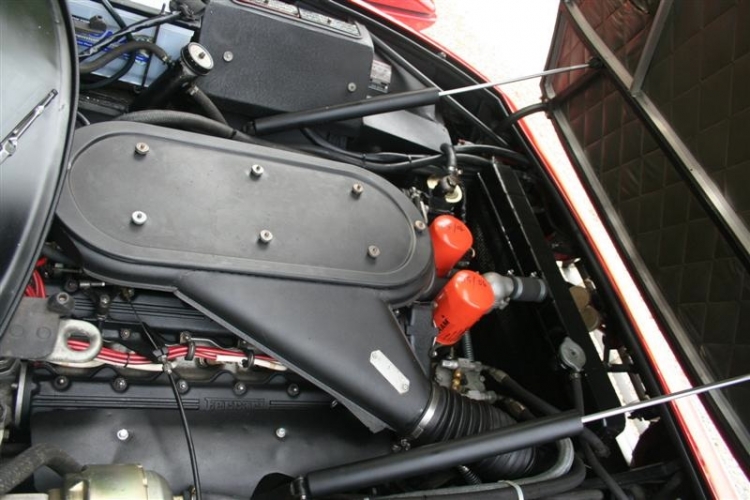
The C4 engine was the first model to receive a new engine designation system and is known as the F101. As the car's name implies, it also features 4 cams but I'm reliably informed by people who understand the oily parts of cars that the head design is different. In order to facilitate the C4's lower bonnet design, the engine uses Weber sidedraft carburettors, which, due to tight under-bonnet access, can be a real pain to maintain. Being the less performance-oriented model, the C4 uses wet-sump lubrication and perhaps most significantly for the driving experience, a conventional gearbox mounted in line with the engine. The shift is also a conventional H pattern and does not have the traditional Ferrari open gate gear selector. Ferrari were uncharacteristically coy about the power output, particularly for the European version, and never revealed official figures. However, depending on which book you read, the C4 makes between 330 and 340bhp at 6800 rpm. The emissions-strangled US versions made 320bhp at 6600rpm. Incidentally, Ferrari always claimed the same power for both US and European/UK versions of the Daytona.
Those sidedraft carburettors do make the C4's engine a rather more interesting unit to look at; the interesting parts of the Daytona's unit are covered by a rather large air filter cover. Some people remove this and replace it with open intake trumpets, but I don't think this is the best thing for engine life!
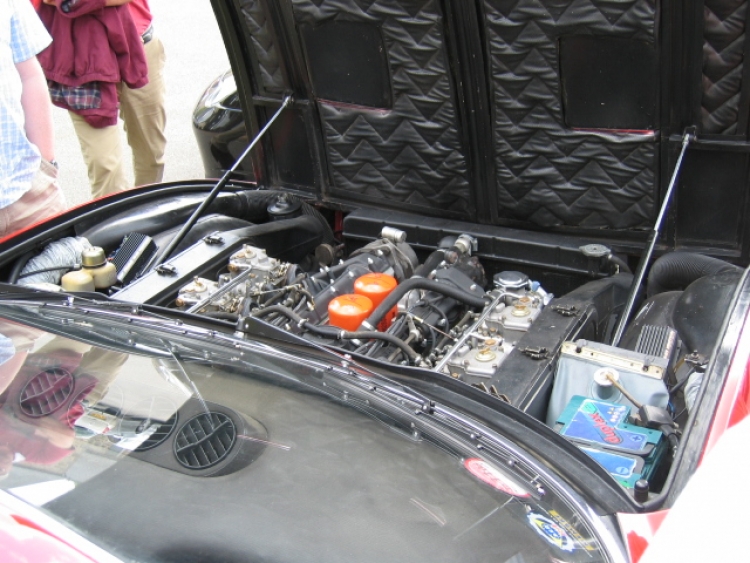
Suspension-wise, both cars use the classic double wishbone arrangement all round, though Ferrari chose to emphasise the touring nature of the C4 by fitting the car with self-levelling rear suspension. The units used were very complicated and often fail. Replacements are difficult to source and tend to be expensive, so a lot of C4s including the test car have had these replaced with Koni adjustable coilover units.
Wheels and tyres are identical 7.5 by 15” rims front and rear with 215/70 tyres. Michelin XWXs were the standard fit when new but both my Daytona and the test C4 sport more modern Pirelli P4000s. Many Daytonas are fitted with wider 9” rims at the rear and this was available as an option when new on later models to homologate wider rims for the race versions. Most Daytonas sporting wider rears today have actually had later wheels from the Ferrari Boxer fitted. My car retains the standard 7.5” rims.
The Daytona's steering is not power-assisted, whereas the C4 does feature power assistance. However, my Daytona has been fitted with the power steering unit from a later Ferrari 400, a car which shares much with the C4.
Inside the Cockpit
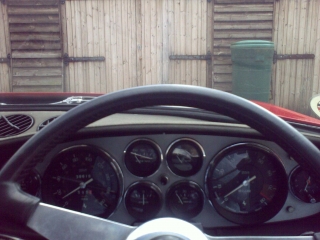 The Daytona has a remarkably simple cockpit. The dash has clear traditional dials made by Veglia, with a speedometer which reads to 180mph. The centre of the dash has four levers for heating controls and an (optional) air-conditioning unit mounted under the dash. The radio is rather awkwardly mounted in the centre console, but I never use it anyway! Windows work electrically from two switches on the centre console. The Daytona was clearly designed to be left-hand drive from the outset, since the gear lever is offset to the left. For right-hand drive examples, Ferrari did not want to go to the expense of repositioning the lever and merely angled the shaft of the lever towards the driver. The Daytona has the traditional Ferrari gate selector but for reasons only known to the UK importer at the time, this is covered by a leather boot on UK cars.
The Daytona has a remarkably simple cockpit. The dash has clear traditional dials made by Veglia, with a speedometer which reads to 180mph. The centre of the dash has four levers for heating controls and an (optional) air-conditioning unit mounted under the dash. The radio is rather awkwardly mounted in the centre console, but I never use it anyway! Windows work electrically from two switches on the centre console. The Daytona was clearly designed to be left-hand drive from the outset, since the gear lever is offset to the left. For right-hand drive examples, Ferrari did not want to go to the expense of repositioning the lever and merely angled the shaft of the lever towards the driver. The Daytona has the traditional Ferrari gate selector but for reasons only known to the UK importer at the time, this is covered by a leather boot on UK cars.
The seats are excellent buckets which provide support where you need it and movement where you don't. The driving position is quite laid back and suits my 6’2" frame quite well. The wheel is a large diameter leather-covered item (early ones were wood). It is angled slightly oddly, which sometimes generated unfavourable comparisons with a bus. The seat is set quite low in the car and positioned close to the rear axle.
On stepping from the Daytona to the C4, the immediate sense is of a more modern car despite there only being three years between the respective launches. I suspect the main reason for the difference is the Fiat influence on the design; the instrument units used are generic items, possibly from the more expensive Fiats of the same era. The instrument pod is nowhere near as attractive as that in the Daytona, and not nearly as easy to read. In my preferred driving position, the cowl on top of the dash obscures the tops of the dials which is rather annoying at motorway speeds. The wheel is quite close to the cowl too, and the backs of your fingers can brush against it as you turn the wheel.
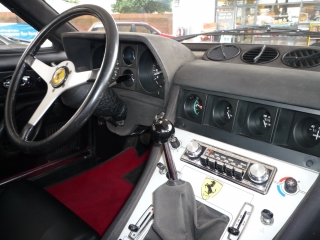 The rest of the cockpit is dominated by the very wide transmission tunnel, the width being necessary to accommodate the in-line gearbox. The gear stick sits atop this and is handily placed close to the steering wheel in a style reminiscent of many touring car racers. Air conditioning is standard, and works rather better than the Daytona's unit which only blows nice and cold when it is cold outside! All other ancillary switches are on the centre console.
The rest of the cockpit is dominated by the very wide transmission tunnel, the width being necessary to accommodate the in-line gearbox. The gear stick sits atop this and is handily placed close to the steering wheel in a style reminiscent of many touring car racers. Air conditioning is standard, and works rather better than the Daytona's unit which only blows nice and cold when it is cold outside! All other ancillary switches are on the centre console.
The C4 does not have the bucket seats of the Daytona and I find them rather thin and lacking in support, particularly under the thighs. The transmission tunnel also means that you are sitting rather more outboard of the centre line in the newer design. The positioning of the seats leads to a much higher driving position than the Daytona and a sense that you’re sitting on rather than in them.
The rear seat is a bench and as already mentioned, can only really be used for small children. The back of the seat folds down so the space can be used as additional luggage capacity, for which this area is probably best suited. The Daytona also has a small parcel shelf behind the seats for storage.
Both cars have reasonably-sized boots, certainly ample enough for the requirements for a weekend away for two. The C4's is larger, though, and slightly better shaped. It does have quite a high loading lip so care needs to be taken not to scratch the paint if lifting in heavy bags.
Performance and handling
Loading lips are all well and good, but I'm pretty sure most readers will be far more concerned with how the two cars perform. The Daytona's performance figures are pretty well known. A top speed of 175mph and a 0–60mph time in around 5.5 seconds (a little less or a little more depending on which of the contemporary road tests you read) would allow the Daytona to stand up and be counted with modern performance cars. Contemporary road tests reports for the C4 are harder to come by, but Paul Frère did put some numbers to the car in period. He achieved a top speed of 149mph (Ferrari claimed a top speed of 162mph) and a 0-62 time of 7.2 seconds. Respectable figures, sure, but the additional weight and reduced power do take their toll on outright acceleration.
Some thirty-eight years later, raw numbers become rather irrelevant, since if you want out-and-out performance from your Ferrari, it's much better to buy a new 599 or California. The way they drive is the important thing here, and this is where the ultimate decision needs to made as to whether the C4 is a credible Daytona alternative.
In the Daytona, the dominant sensation is the level of mechanical noise, both from the engine and gearbox. All the mechanical machinations make for a very pleasant sound and contribute greatly to the racy feel of the car. The low seating position makes you feel very much at one with the car, and since you're positioned close to the back axle, allows quite a lot of communication as to what the rear of the car is doing. The steering on a regular Daytona is very heavy at low speeds but the power steering fitted to mine takes the edge off. The downside to this modification is some vagueness at speed. Like many Italian cars, there is something of a dead spot around the straight ahead point of the steering but it's not excessive. Despite the vagueness, there is quite a lot of communication back through the wheel. If you hit a bump the wheel can twitch widely, and it's enough to consider a rally-style thumbs on the rim approach to holding the wheel.
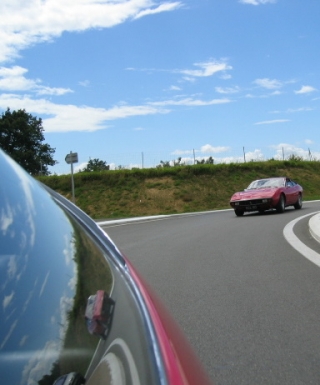 Moving over to the C4, the higher seating position makes you feel rather less involved in the whole experience. The car is significantly quieter too, although since this C4 has been restored fairly recently, this may be down to improved sound deadening material being installed. The steering shares the same vagueness about the straight ahead and being power assisted by design, feels lighter still than my modified Daytona. On the whole, the C4 steering has far less feel than the older design, but significantly doesn't have any of the kickback that the Daytona has either. The C4 is wider than the Daytona, too, and as a result can feel less agile on country roads. The more offset driving position doesn't help here either.
Moving over to the C4, the higher seating position makes you feel rather less involved in the whole experience. The car is significantly quieter too, although since this C4 has been restored fairly recently, this may be down to improved sound deadening material being installed. The steering shares the same vagueness about the straight ahead and being power assisted by design, feels lighter still than my modified Daytona. On the whole, the C4 steering has far less feel than the older design, but significantly doesn't have any of the kickback that the Daytona has either. The C4 is wider than the Daytona, too, and as a result can feel less agile on country roads. The more offset driving position doesn't help here either.
Depending on your point of view, one area that the C4 scores significantly over the Daytona is the gearbox. The Daytona's dogleg unit takes a lot of mastering. The lever doesn't move freely around the gate until the oil is completely warm and second gear is best avoided for the first few miles. The C4's H pattern 'box is much easier to use, and the clutch is a lot lighter too. While it can be a little stiff until the oil is warm, it's perfectly usable from the get-go. That said, for many owners, mastering the Daytona's gearbox is one of the most important aspects to the experience of driving the Daytona and while the C4 may have the better shift, it misses out on one of the key aspects that makes the more famous car feel so special.
As with most classic and performance cars, warm-up is something that needs to be taken into consideration since both cars respond rather better once some heat has got into the various oils. Take a short drive of 20 miles or less in a Daytona that has started from stone cold and the chances are you won't like it very much. Persevere, and once the mechanicals have warmed up properly, the car really comes alive. The C4 is quicker to respond in this respect, but even this is a car that gets better as the journey gets longer.

Both cars have the same brakes and braking systems, yet the Daytona feels far more confidence-inspiring when you press the middle pedal. The lighter weight of the Daytona may have something to do with this, but whatever the reason, the brake pedal on the C4 is much softer and as a result you don't feel like you can really lean on the brakes.
With similar wheel and tyre sizes, both cars produce similar levels of grip. I've not driven either right to the edge of their respective handling envelopes, but I suspect neither one is the sort of car you would want to push to the limits unless you're an extremely talented driver. The transaxle on the Daytona can lead to an unexpected turning moment if the slip angle gets too great, and the steering is probably not quick enough to gather the resulting moment back up. I've only ever had the rear of the Daytona step out once and that was on a damp hairpin in France. Slightly too much throttle had the back end squirming; nothing serious, but a reminder that these cars can still bite.
The C4 is rather too big and heavy to be a sideways hero, and that style of driving doesn't suit the laid-back demeanour of the car anyway. At sensible speeds both cars have very neutral handling characteristics. They also ride well, arguably better than many of their modern counterparts over challengingly-surfaced UK roads, though the tall 70-section tyres contribute greatly to the smooth ride. The C4 is probably the better car at smoothing out the bumps, though. Ride heights are also higher than modern cars, and both can negotiate speed humps that would outfox a modern Ferrari. Care does need to be taken not to catch the low-slung exhausts on the Daytona, however.
The ultimate raison d'être for both cars is as grand tourers. In an era before budget airlines, both could be used to cover great distances across continents in speed and comfort. Neither car is especially economical, though from experience the lighter Daytona is marginally more frugal than the C4. This is all relatively speaking, though; your credit card will pay a heavy price at the pumps with either car, since both are unlikely to return much beyond 14mpg. To give the cars a respectable range with such thirsty engines, they're fitted with large 120-litre fuel tanks.
Conclusion
The question of this test was never which car was better, nor which one I prefer; the answer for me to the latter question is obviously the Daytona! Instead, it was to establish whether or not the C4 can be considered a true alternative to the Daytona. In my opinion, the answer is a resounding no. The C4 just doesn't offer the level of driver involvement that the Daytona does.
That's not to say that the C4 is a bad car - far from it, in fact. In many ways it's a better proposition and I can see why some owners prefer a car that's easier to drive, more refined and, if you find the seats comfortable, probably the better place to be on a long journey. My Dad certainly prefers the way the C4 drives to the Daytona, and he drives both C4s extensively - the red example in the photographs has racked up 15,000 miles in the last few years, including several trips around Europe. However, it's just not a car to get the pulse racing, and you sometimes have to look at the prancing horse on the steering wheel to remind you that it is actually a Ferrari.
Even if the prancing horse badge was covered up, the Daytona could only be a Ferrari. Like the C4, it may have been conceived primarily as a road car, but it can trace its lineage directly back to the likes of the Ferrari 250SWB, a car that was designed to be both a road and race car. It's this DNA that shines through in the Daytona, and driving it is exactly how you would imagine driving a Ferrari to be, a road car with the heart of a racer.
